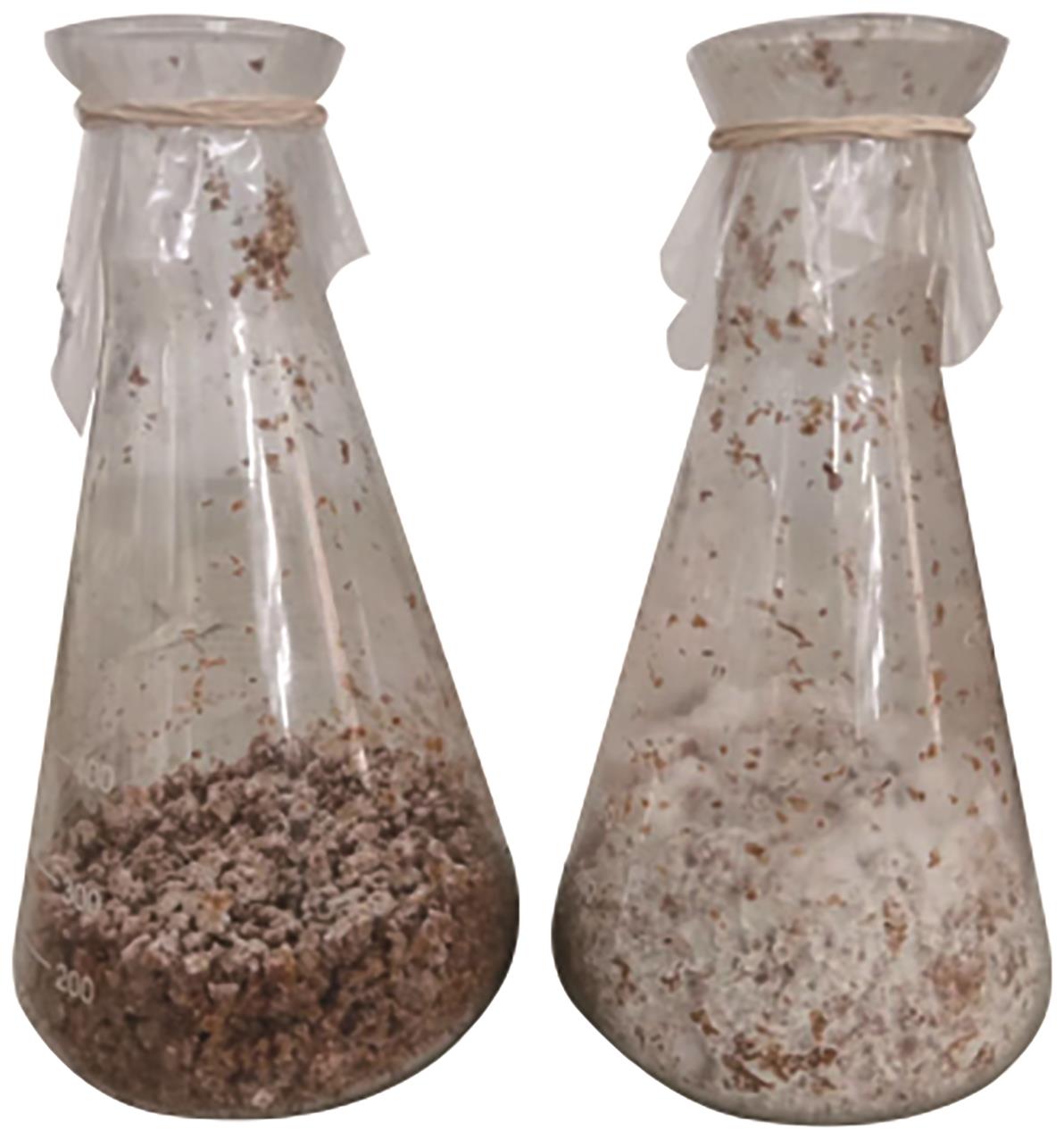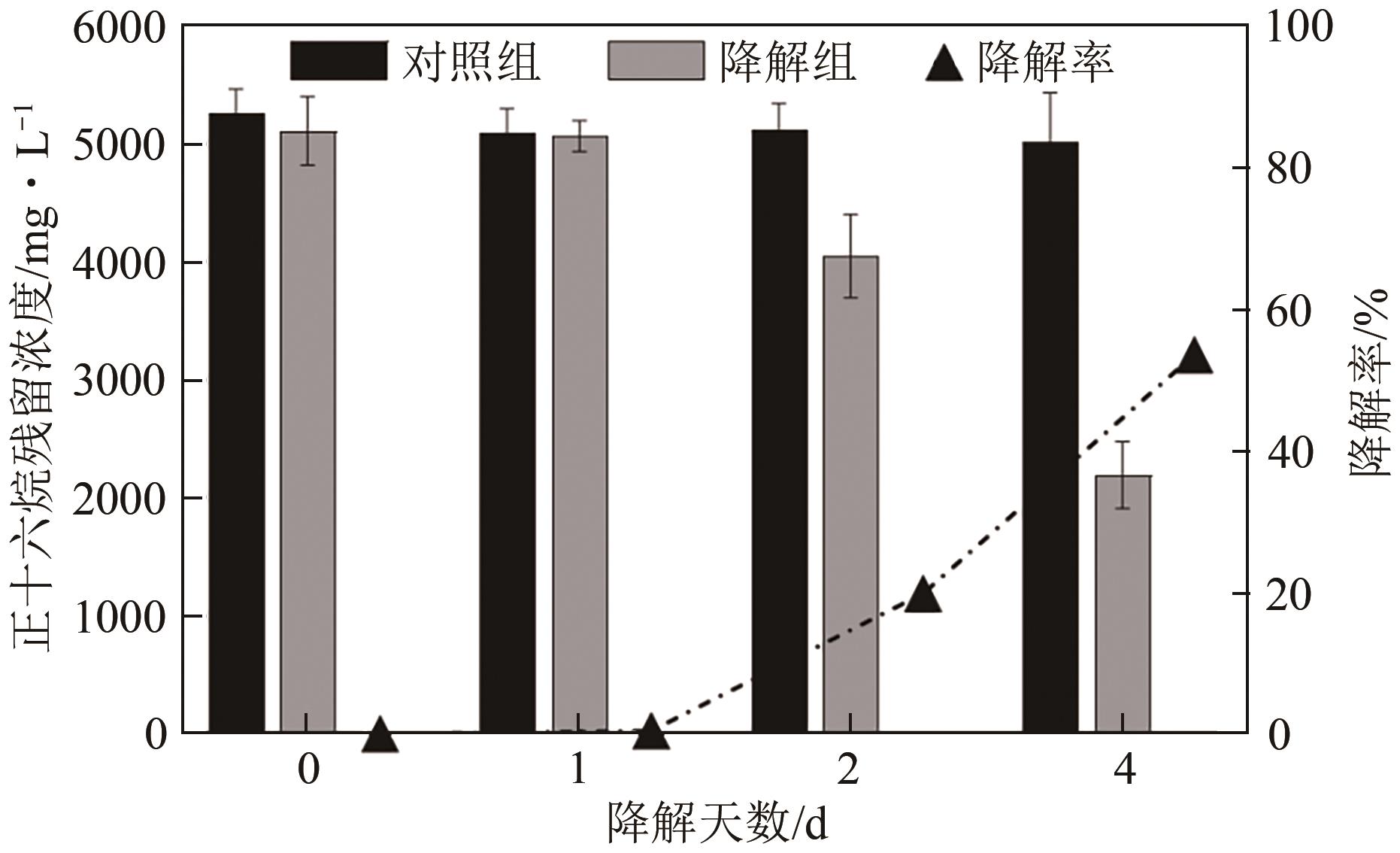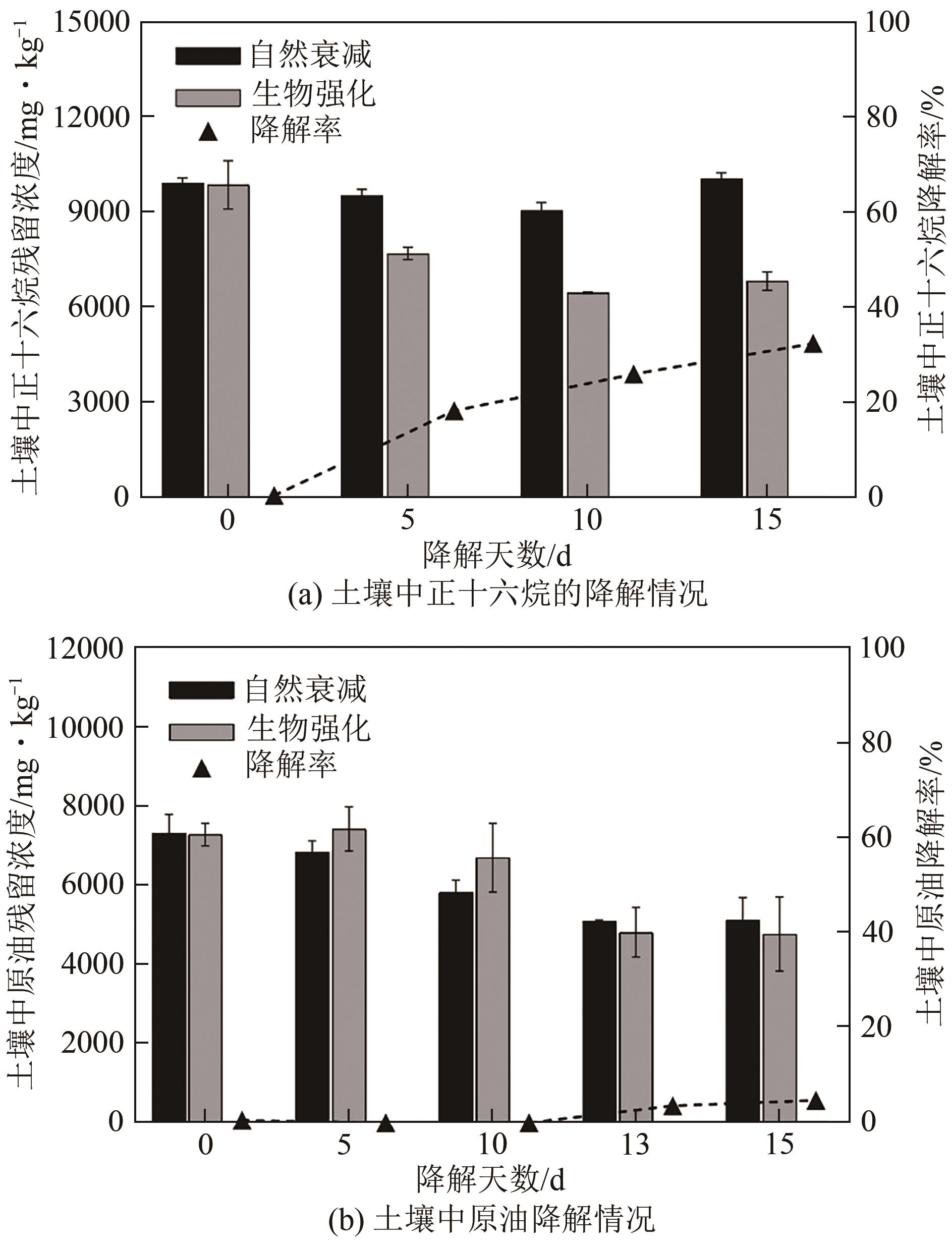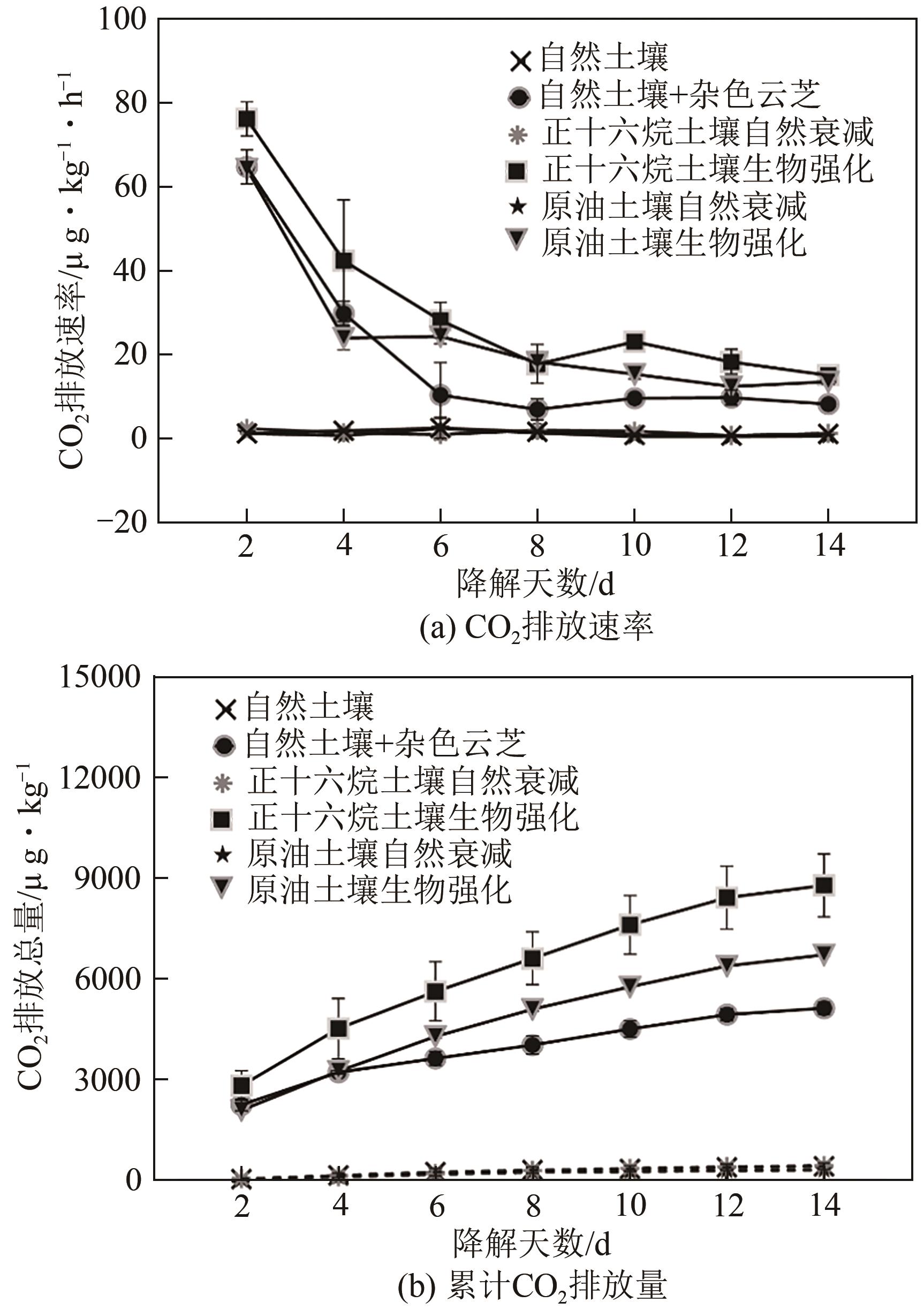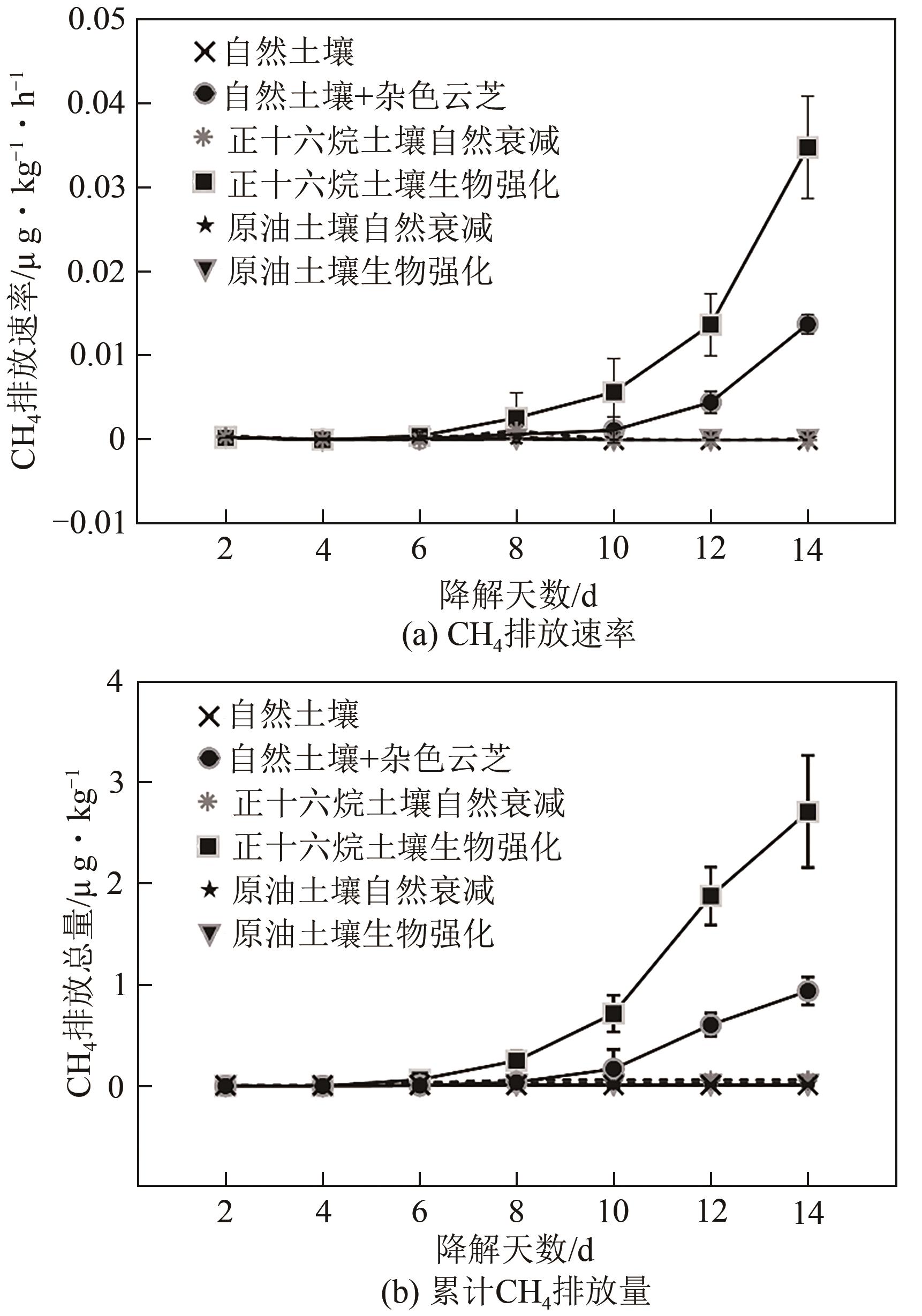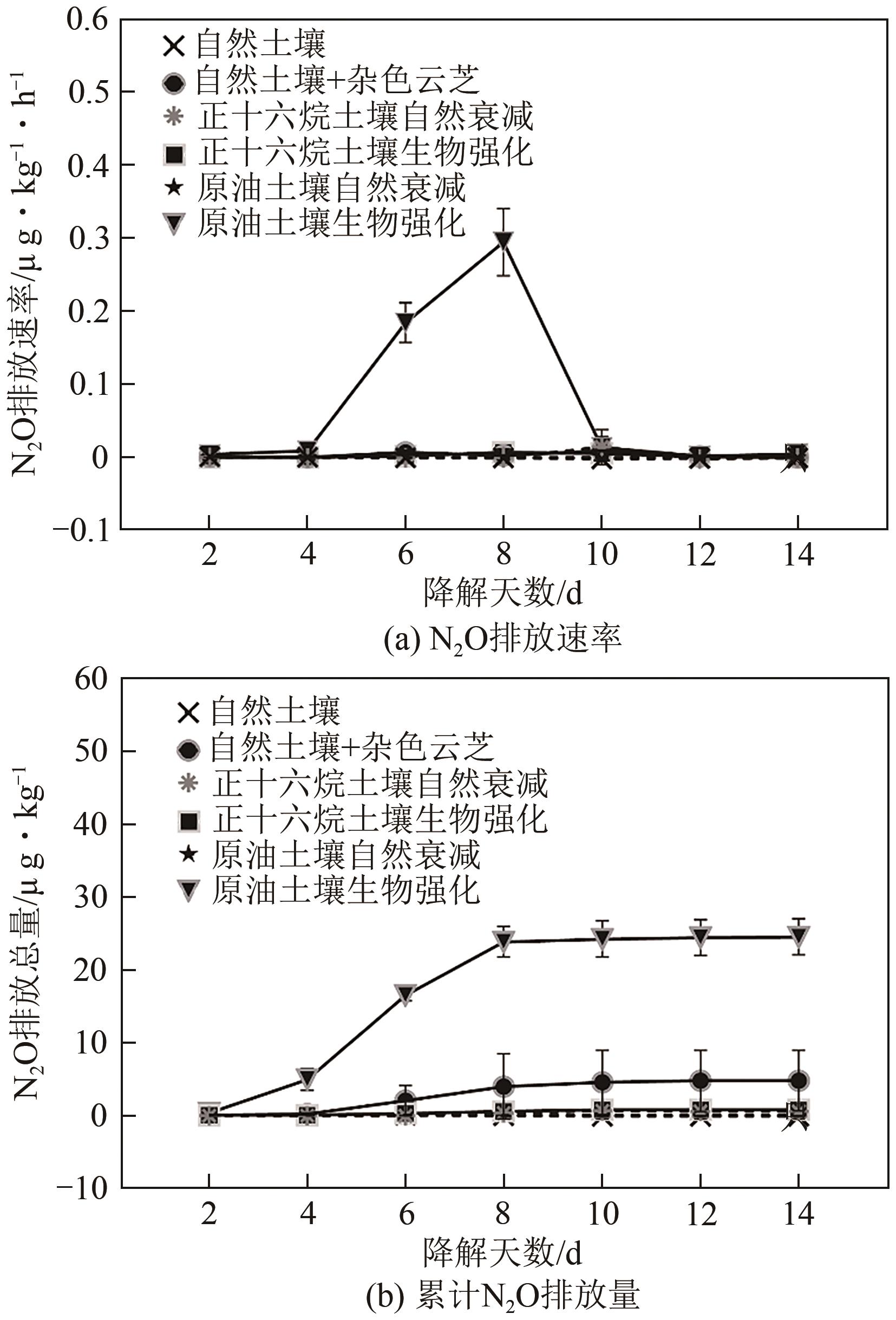化工进展 ›› 2024, Vol. 43 ›› Issue (10): 5922-5931.DOI: 10.16085/j.issn.1000-6613.2023-1652
• 资源与环境化工 • 上一篇
Trametes versicolor修复石油烃污染土壤及温室气体释放特征
- 1.北京建筑大学城市环境修复技术研究中心,北京 100044
2.北京节能减排与城乡可持续发展省部共建协同创新中心,北京 100044
-
收稿日期:2023-09-18修回日期:2023-11-23出版日期:2024-10-15发布日期:2024-10-29 -
通讯作者:高大文 -
作者简介:白雨虹(1997—),女,硕士研究生,研究方向为石油烃污染场地生物修复。E-mail:b1004618690@163.com。 -
基金资助:国家重点研发计划(2020YFC1808801)
Remediation of petroleum hydrocarbon contaminated soil by Trametes versicolor and characterization of greenhouse gas release
BAI Yuhong1,2( ), GAO Dawen1,2(
), GAO Dawen1,2( )
)
- 1.Centre for Urban Environmental Remediation, Beijing University of Civil Engineering and Architecture, Beijing 100044, China
2.Beijing Energy Conservation & Sustainable Urban and Rural Development Provincial and Ministry Co-Construction Collaboration Innovation Center, Beijing University of Civil Engineering and Architecture, Beijing 100044, China
-
Received:2023-09-18Revised:2023-11-23Online:2024-10-15Published:2024-10-29 -
Contact:GAO Dawen
摘要:
石油烃是环境中一种难降解的物质,物理化学修复技术成本高、能耗大且不利于环境恢复。杂色云芝(Trametes versicolor)的菌丝能够均质化土壤,是石油烃生物修复的潜在微生物。本文以不同类型石油烃污染为研究对象,以降解率为考核指标,探究杂色云芝对不同类型石油烃的降解性能。在此基础上,研究杂色云芝对石油烃污染土壤的生物修复作用及对温室气体释放的影响,为石油烃污染土壤的生物修复技术应用提供理论指导。结果表明:杂色云芝能有效降解不同类型石油烃,4天内正十六烷被去除了53.55%,9天内原油被去除了21.61%。利用杂色云芝降解模拟污染土壤中的石油烃,修复15天后,正十六烷的去除率达到32.68%,原油的去除率达到4.84%。正十六烷污染的土壤中,污染物被降解并以CO2和CH4的形式释放到环境中,在原油污染的土壤中,CH4的释放量较少,而CO2和N2O的释放量增加。研究结果证明了杂色云芝修复不同类型石油烃污染土壤的可能性,提供了生物修复能产生更少温室气体的理论依据。
中图分类号:
引用本文
白雨虹, 高大文. Trametes versicolor修复石油烃污染土壤及温室气体释放特征[J]. 化工进展, 2024, 43(10): 5922-5931.
BAI Yuhong, GAO Dawen. Remediation of petroleum hydrocarbon contaminated soil by Trametes versicolor and characterization of greenhouse gas release[J]. Chemical Industry and Engineering Progress, 2024, 43(10): 5922-5931.
| 序号 | 实验组 | 实验设置 |
|---|---|---|
| 1 | 正十六烷污染土壤自然衰减 | 正十六烷污染土壤+定期补水 |
| 2 | 正十六烷污染土壤生物强化 | 正十六烷污染土壤+10%杂色云芝菌剂+定期补水 |
| 3 | 原油污染土壤自然衰减 | 原油污染土壤+定期补水 |
| 4 | 原油污染土壤生物强化 | 原油污染土壤+10%杂色云芝菌剂+定期补水 |
表1 实验分组表
| 序号 | 实验组 | 实验设置 |
|---|---|---|
| 1 | 正十六烷污染土壤自然衰减 | 正十六烷污染土壤+定期补水 |
| 2 | 正十六烷污染土壤生物强化 | 正十六烷污染土壤+10%杂色云芝菌剂+定期补水 |
| 3 | 原油污染土壤自然衰减 | 原油污染土壤+定期补水 |
| 4 | 原油污染土壤生物强化 | 原油污染土壤+10%杂色云芝菌剂+定期补水 |
| 序号 | 实验组 | 实验设置 |
|---|---|---|
| 1 | 自然土壤 | 未污染土壤+定期补水 |
| 2 | 自然土壤 | 未污染土壤+10%杂色云芝菌剂+定期补水 |
| 3 | 正十六烷土壤 | 正十六烷污染土壤+定期补水 |
| 4 | 正十六烷土壤 | 正十六烷污染土壤+10%杂色云芝菌剂+定期补水 |
| 5 | 原油土壤 | 原油污染土壤+定期补水 |
| 6 | 原油土壤 | 原油污染土壤+10%杂色云芝菌剂+定期补水 |
表2 实验分组表
| 序号 | 实验组 | 实验设置 |
|---|---|---|
| 1 | 自然土壤 | 未污染土壤+定期补水 |
| 2 | 自然土壤 | 未污染土壤+10%杂色云芝菌剂+定期补水 |
| 3 | 正十六烷土壤 | 正十六烷污染土壤+定期补水 |
| 4 | 正十六烷土壤 | 正十六烷污染土壤+10%杂色云芝菌剂+定期补水 |
| 5 | 原油土壤 | 原油污染土壤+定期补水 |
| 6 | 原油土壤 | 原油污染土壤+10%杂色云芝菌剂+定期补水 |
| 1 | Nilanjana DAS, CHANDRAN Preethy. Microbial degradation of petroleum hydrocarbon contaminants: An overview[J]. Biotechnology Research International, 2011, 2011: 1-13. |
| 2 | LIANG Yuting, ZHANG Xu, ZHOU Jizhong, et al. Long-term oil contamination increases deterministic assembly processes in soil microbes[J]. Ecological Applications, 2015, 25(5): 1235-1243. |
| 3 | VARJANI Sunita J. Microbial degradation of petroleum hydrocarbons[J]. Bioresource Technology, 2017, 223: 277-286. |
| 4 | HOANG Son A, LAMB Dane, SESHADRI Balaji, et al. Rhizoremediation as a green technology for the remediation of petroleum hydrocarbon-contaminated soils[J]. Journal of Hazardous Materials, 2021, 401: 123282. |
| 5 | VARJANI Sunita J, GNANSOUNOU Edgard, PANDEY Ashok. Comprehensive review on toxicity of persistent organic pollutants from petroleum refinery waste and their degradation by microorganisms[J]. Chemosphere, 2017, 188: 280-291. |
| 6 | KEBEDE Gessesse, TAFESE Tekle, ABDA Ebrahim M, et al. Factors influencing the bacterial bioremediation of hydrocarbon contaminants in the soil: Mechanisms and impacts[J]. Journal of Chemistry, 2021, 2021: 1-17. |
| 7 | SAKSHI, SINGH S K, HARITASH A K. Polycyclic aromatic hydrocarbons: Soil pollution and remediation[J]. International Journal of Environmental Science and Technology, 2019, 16(10): 6489-6512. |
| 8 | 薛成杰, 方战强. 土壤修复产业碳达峰碳中和路径研究[J]. 环境工程, 2022, 40(8): 231-238. |
| XUE Chengjie, FANG Zhanqiang. Path of carbon emission peaking and carbon neutrality in soil remediation industry[J]. Environmental Engineering, 2022, 40(8): 231-238. | |
| 9 | GAO Dawen, ZHAO Huan, WANG Litao, et al. Current and emerging trends in bioaugmentation of organic contaminated soils: A review[J]. Journal of Environmental Management, 2022, 320: 115799. |
| 10 | 陈紫彤. 氧化通风法修复石油类污染土壤技术研究[D]. 石家庄: 河北科技大学, 2020. |
| CHEN Zitong. Study on technology of remediation for petroleum-contaminated soil by oxidation ventilation[D]. Shijiazhuang: Hebei University of Science and Technology, 2020. | |
| 11 | DACCÒ C, GIROMETTA C, ASEMOLOYE M D, et al. Key fungal degradation patterns, enzymes and their applications for the removal of aliphatic hydrocarbons in polluted soils: A review[J]. International Biodeterioration & Biodegradation, 2020, 147: 104866. |
| 12 | KADRI Tayssir, ROUISSI Tarek, KAUR BRAR Satinder, et al. Biodegradation of polycyclic aromatic hydrocarbons (PAHs) by fungal enzymes: A review[J]. Journal of Environmental Sciences, 2017, 51: 52-74. |
| 13 | FENG Leiyu, JIANG Xiupeng, HUANG Yanning, et al. Petroleum hydrocarbon-contaminated soil bioremediation assisted by isolated bacterial consortium and sophorolipid[J]. Environmental Pollution, 2021, 273: 116476. |
| 14 | OMONI Victor T, IBETO Cynthia N, LAG-BROTONS Alfonso J, et al. Impact of lignocellulosic waste-immobilised white-rot fungi on enhancing the development of 14C-phenanthrene catabolism in soil[J]. Science of the Total Environment, 2022, 811: 152243. |
| 15 | AHMAD MALIK Nazir, KUMAR Jitender, WANI Mohammad Saleem, et al. Role of mushrooms in the bioremediation of soil[M]//DAR Gowhar Hamicl, AHMAD Bhat Rouf, MEHMOOD Mohammad Aneesul, et al. Microbiota and Biofertilizers, Vol 2: Ecofriendly Tools for Reclamation of Degraded Soil Environs. Cham: Springer International Publishing, 2021: 77-102. |
| 16 | OMONI Victor T, LAG-BROTONS Alfonso J, IBETO Cynthia N, et al. Effects of biological pre-treatment of lignocellulosic waste with white-rot fungi on the stimulation of 14C-phenanthrene catabolism in soils[J]. International Biodeterioration & Biodegradation, 2021, 165: 105324. |
| 17 | GU Jidong. On environmental biotechnology of bioremediation[J]. Applied Environmental Biotechnology, 2021, 5(2): 3-8. |
| 18 | LI Aiyang, LI Guanghe, YANG Juejie, et al. Geo-distribution pattern of microbial carbon cycling genes responsive to petroleum contamination in continental horizontal oilfields[J]. Science of the Total Environment, 2020, 731: 139188. |
| 19 | 付辉, 孟瑶, 梁红, 等. 复合白腐真菌菌剂修复原油污染土壤[J]. 森林工程, 2012, 28(4): 17-20. |
| FU Hui, MENG Yao, LIANG Hong, et al. Restoration of oil polluted soil using combined fungus of white-rot fungi and microbial inoculum[J]. Forest Engineering, 2012, 28(4): 17-20. | |
| 20 | 高恩丽. 云芝漆酶的生产及其应用基础研究[D]. 杭州: 浙江大学, 2007. |
| GAO Enli. Production and application of the laccase from coriolus versicolor[D]. Hangzhou: Zhejiang University, 2007. | |
| 21 | ZHEN Meinan, TANG Jingchun, LI Chao, et al. Rhamnolipid-modified biochar-enhanced bioremediation of crude oil-contaminated soil and mediated regulation of greenhouse gas emission in soil[J]. Journal of Soils and Sediments, 2021, 21(1): 123-133. |
| 22 | CAI Yanjiang, WANG Xiaodan, DING Weixin, et al. Potential short-term effects of yak and Tibetan sheep dung on greenhouse gas emissions in two alpine grassland soils under laboratory conditions[J]. Biology and Fertility of Soils, 2013, 49(8): 1215-1226. |
| 23 | ADETUTU Eric M, BALL Andy S, WEBER John, et al. Impact of bacterial and fungal processes on 14C-hexadecane mineralisation in weathered hydrocarbon contaminated soil[J]. Science of the Total Environment, 2012, 414: 585-591. |
| 24 | KHEIRKHAH Tolue, HEJAZI Parisa, RAHIMI Azita. Effects of utilizing sawdust on non-ligninolytic degradation of high concentration of n-hexadecane by white-rot fungi: Kinetic analysis of solid-phase bioremediation[J]. Environmental Technology & Innovation, 2020, 19: 100887. |
| 25 | KANALY Robert A, Hor-Gil HUR. Growth of Phanerochaete chrysosporium on diesel fuel hydrocarbons at neutral pH[J]. Chemosphere, 2006, 63(2): 202-211. |
| 26 | YANG Yuyin, Wang Jie, Liao Jingqiu, et al. Abundance and diversity of soil petroleum hydrocarbon-degrading microbial communities in oil exploring areas[J]. Applied microbiology and biotechnology, 2015, 99: 1935-1946. |
| 27 | RUBILAR O, TORTELLA G, CEA M, et al. Bioremediation of a Chilean Andisol contaminated with pentachlorophenol (PCP) by solid substrate cultures of white-rot fungi[J]. Biodegradation, 2011, 22(1): 31-41. |
| 28 | HUANG Yongjie, PAN Huan, WANG Qingling, et al. Enrichment of the soil microbial community in the bioremediation of a petroleum-contaminated soil amended with rice straw or sawdust[J]. Chemosphere, 2019, 224: 265-271. |
| 29 | ZHANG Jie, YUAN Jing, WANG Qingling, et al. Enhanced bioremediation of PAH-contaminated soil by wheat bran and microbial community response[J]. Archives of Agronomy and Soil Science, 2020, 66(8): 1089-1102. |
| 30 | ZHANG Xinying, KONG Dewen, LIU Xiaoyan, et al. Combined microbial degradation of crude oil under alkaline conditions by Acinetobacter baumannii and Talaromyces sp[J]. Chemosphere, 2021, 273: 129666. |
| 31 | BRZESZCZ Joanna, KASZYCKI Paweł. Aerobic bacteria degrading both n-alkanes and aromatic hydrocarbons: An undervalued strategy for metabolic diversity and flexibility[J]. Biodegradation, 2018, 29(4): 359-407. |
| 32 | SVERDRUP Line E, NIELSEN Torben, KROGH Paul Henning. Soil ecotoxicity of polycyclic aromatic hydrocarbons in relation to soil sorption, lipophilicity, and water solubility[J]. Environmental Science & Technology, 2002, 36(11): 2429-2435. |
| 33 | GIOVANELLA Patricia, DE AZEVEDO DUARTE Lídia, KITA Daniela Mayumi, et al. Effect of biostimulation and bioaugmentation on hydrocarbon degradation and detoxification of diesel-contaminated soil: A microcosm study[J]. Journal of Microbiology, 2021, 59(7): 634-643. |
| 34 | LLADÓ S, COVINO S, SOLANAS A M, et al. Pyrosequencing reveals the effect of mobilizing agents and lignocellulosic substrate amendment on microbial community composition in a real industrial PAH-polluted soil[J]. Journal of Hazardous Materials, 2015, 283: 35-43. |
| 35 | LLADÓ S, SOLANAS A M, DE LAPUENTE J, et al. A diversified approach to evaluate biostimulation and bioaugmentation strategies for heavy-oil-contaminated soil[J]. Science of the Total Environment, 2012, 435/436: 262-269. |
| 36 | 李倩, 杨璐, 姜越, 等. 农药生产场地污染土壤的化学氧化修复技术研究进展[J]. 生态与农村环境学报, 2021, 37(1): 19-29. |
| LI Qian, YANG Lu, JIANG Yue, et al. Chemical oxidation techniques for soil remediation of contamination at pesticide-production sites[J]. Journal of Ecology and Rural Environment, 2021, 37(1): 19-29. | |
| 37 | 和丽萍, 李丽娜, 陈异晖, 等. 云南某焦化厂多环芳烃污染红壤异位热脱附修复效率[C]//中国环境科学学会环境工程分会. 中国环境科学学会2019年科学技术年会——环境工程技术创新与应用分论坛论文集(二).《工业建筑》杂志社有限公司, 2019: 294-298, 356. |
| HE Liping, LI Lina, CHEN Yihui, et al. Repair efficency of ectopia thermal desorption of PAHs polluted red soil in a coking plant in Yunnan[C]// Chinese Society of Environmental Science, Environmental Engineering Branch. Proceedings of the 2019 Annual Scientific and Technical Conference of the Chinese Society of Environmental Sciences—Subforum on Technological Innovation and Application of Environmental Engineering (Ⅱ). Industrial Construction Magazine Agency Co., Ltd., 2019: 294-298, 356. | |
| 38 | YANG Juejie, LI Guanghe, QIAN Yi, et al. Microbial functional gene patterns related to soil greenhouse gas emissions in oil contaminated areas[J]. Science of the Total Environment, 2018, 628/629: 94-102. |
| 39 | DOLFING Jan, LARTER Stephen R, HEAD Ian M. Thermodynamic constraints on methanogenic crude oil biodegradation[J]. The ISME Journal, 2008, 2(4): 442-452. |
| 40 | JONES D M, HEAD I M, GRAY N D, et al. Crude-oil biodegradation via methanogenesis in subsurface petroleum reservoirs[J]. Nature, 2008, 451(7175): 176-180. |
| 41 | SEO Yoonjoo, CHO Kyung-Suk. Effects of plant and soil amendment on remediation performance and methane mitigation in petroleum-contaminated soil[J]. Journal of Microbiology and Biotechnology, 2021, 31(1): 104-114. |
| 42 | SIHOTA Natasha J, SINGURINDY Olga, Ulrich MAYER K. CO2-efflux measurements for evaluating source zone natural attenuation rates in a petroleum hydrocarbon contaminated aquifer[J]. Environmental Science & Technology, 2011, 45(2): 482-488. |
| 43 | 宋长春, 王毅勇, 王跃思, 等. 人类活动影响下淡水沼泽湿地温室气体排放变化[J]. 地理科学, 2006(1): 82-86. |
| SONG Changchun, WANG Yiyong, WANG Yuesi, et al. Character of the greenhouse gas emission in the freshwater mire under human activities[J]. Scientia Geographica Sinica, 2006, 26(1): 82-86. | |
| 44 | KADRI Tayssir, MAGDOULI Sara, ROUISSI Tarek, et al. Ex-situ biodegradation of petroleum hydrocarbons using Alcanivorax borkumensis enzymes[J]. Biochemical Engineering Journal, 2018, 132: 279-287. |
| 45 | RABUS Ralf, WIDDEL Friedrich. Anaerobic degradation of ethylbenzene and other aromatic hydrocarbons by new denitrifying bacteria[J]. Archives of Microbiology, 1995, 163(2): 96-103. |
| 46 | RIBEIRO Hugo, MUCHA Ana P, AZEVEDO Isabel, et al. Differential effects of crude oil on denitrification and anammox, and the impact on N2O production[J]. Environmental Pollution, 2016, 216: 391-399. |
| [1] | 张杰, 王放放, 夏忠林, 赵光金, 马双忱. “双碳”目标下SF6排放现状、减排手段分析及未来展望[J]. 化工进展, 2023, 42(S1): 447-460. |
| [2] | 杨静, 李博, 李文军, 刘晓娜, 汤刘元, 刘月, 钱天伟. 焦化污染场地中萘降解菌的分离及降解特性[J]. 化工进展, 2023, 42(8): 4351-4361. |
| [3] | 李佳, 樊星, 陈莉, 李坚. 硝酸生产尾气中NO x 和N2O联合脱除技术研究进展[J]. 化工进展, 2023, 42(7): 3770-3779. |
| [4] | 刘柏成, 李法云, 赵琦慧, 吝美霞. 禾本科植物修复多环芳烃污染土壤研究进展[J]. 化工进展, 2023, 42(7): 3736-3748. |
| [5] | 李若琳, 何少林, 苑宏英, 刘伯约, 纪冬丽, 宋阳, 刘博, 余绩庆, 徐英俊. 原位热解对油页岩物性及地下水水质影响探索[J]. 化工进展, 2023, 42(6): 3309-3318. |
| [6] | 刘丹, 范云洁, 王慧敏, 严政, 李鹏飞, 李家成, 曹雪波. 基于废弃PET的高值化功能性多孔碳材料及其应用进展[J]. 化工进展, 2023, 42(2): 969-984. |
| [7] | 房晓宇, 卢滇楠, 刘铮. 污染土壤生物修复技术的进展与工程应用现状[J]. 化工进展, 2023, 42(12): 6498-6506. |
| [8] | 李致达, 石瑶, 张凤姣, 娄伟, 王琳玲, 盛安旭, 吴晓晖, 昝飞翔, 陈静. 层状双氢氧化物在环境修复领域中的研究进展[J]. 化工进展, 2023, 42(11): 5801-5810. |
| [9] | 颜子涵, 陈群云, 李卓, 付融冰, 李彦伟, 吴志根. 改进型土壤破碎混拌结构的性能数值分析与优化[J]. 化工进展, 2022, 41(S1): 72-80. |
| [10] | 郑瑾, 韩瑞瑞, 李丹丹, 王馨妤, 高春阳, 杜显元, 张晓飞, 邹德勋. 过氧化尿素与微生物联合修复石油污染土壤[J]. 化工进展, 2022, 41(9): 5085-5093. |
| [11] | 吕莹, 胡学武, 陈素素, 刘兴宇, 陈勃伟, 张明江. 多环芳烃污染土壤的微生物修复技术研究进展[J]. 化工进展, 2022, 41(6): 3249-3262. |
| [12] | 慕彦君, 宋倩倩, 王红秋, 付凯妹, 雪晶, 王春娇. 美国炼化行业低碳发展策略与启示[J]. 化工进展, 2022, 41(6): 2797-2805. |
| [13] | 汪林, 蒲思淇, 王明新, 薛金娟, 韩莹. 过碳酸钠修复石油污染土壤及其环境效应[J]. 化工进展, 2022, 41(4): 2171-2179. |
| [14] | 尚丽, 刘双, 沈群, 张凌云, 孙楠楠, 魏伟. 典型二氧化碳利用技术的低碳成效综合评估[J]. 化工进展, 2022, 41(3): 1199-1208. |
| [15] | 郑鹏, 李蔚玲, 郭亚飞, 孙健, 王瑞林, 赵传文. 鼓泡床中电石渣加速碳酸化分析与响应面优化[J]. 化工进展, 2022, 41(3): 1528-1538. |
| 阅读次数 | ||||||
|
全文 |
|
|||||
|
摘要 |
|
|||||
